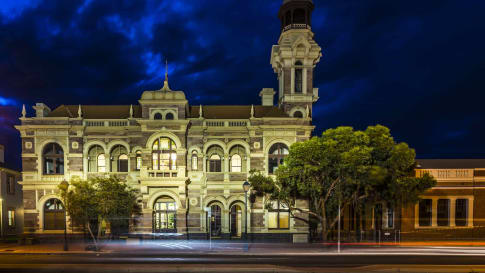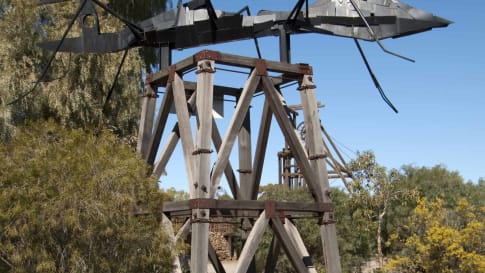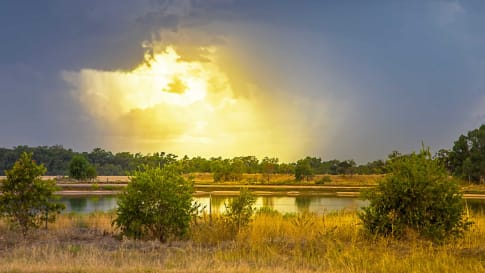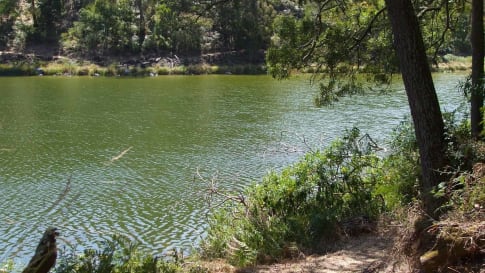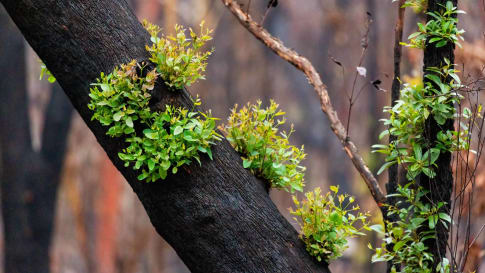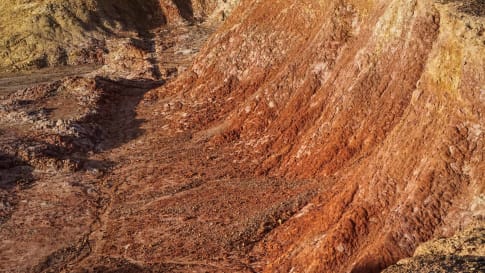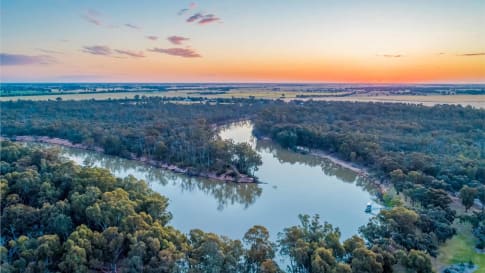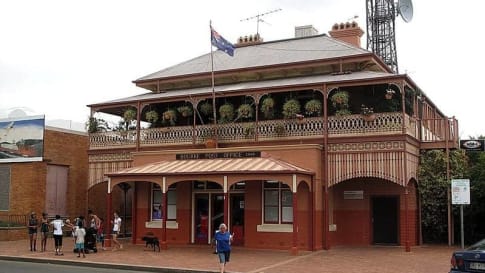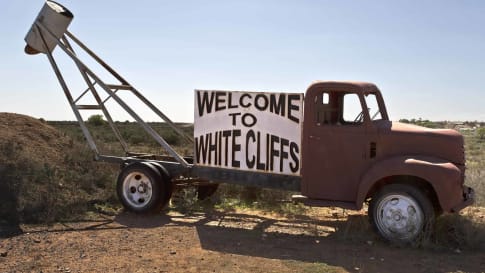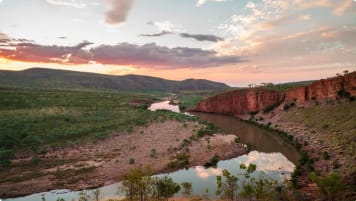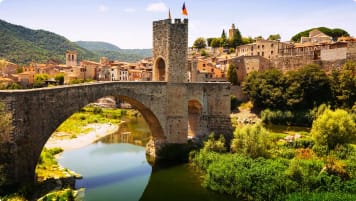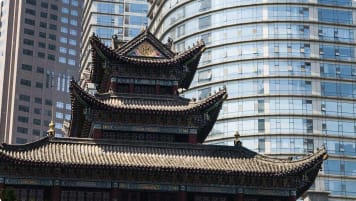Escorted small group tour of Western New South Wales
Discover the the Brewarrina fish traps, Aboriginal art at Mt Grenfell and visit the opal fields of White Cliffs. This small group also visits the World Heritage Site of Mungo man and lady stopping in Mungo National Park and other significant locations such as Broken Hill.
From $8,176CAD
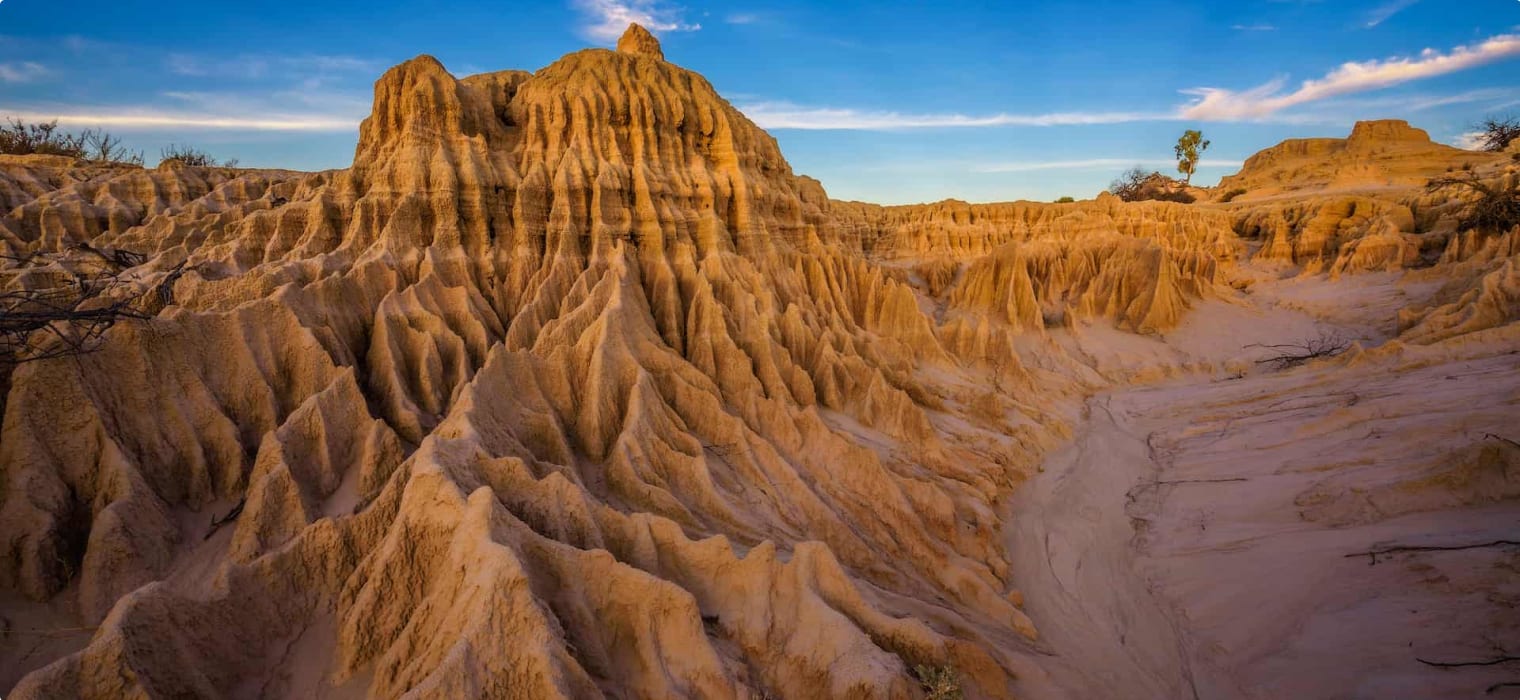
Highlights
- 1. Learn about aquaculture in Aboriginal culture at Brewarrina Fish traps.
- 2. Explore the vibrant outback town of Broken Hill and historic Silverton..
- 3. Explore and stay in White Cliffs Opal settlement.
- 4. Visit Menindee the historic departure point for Burke and Wills.
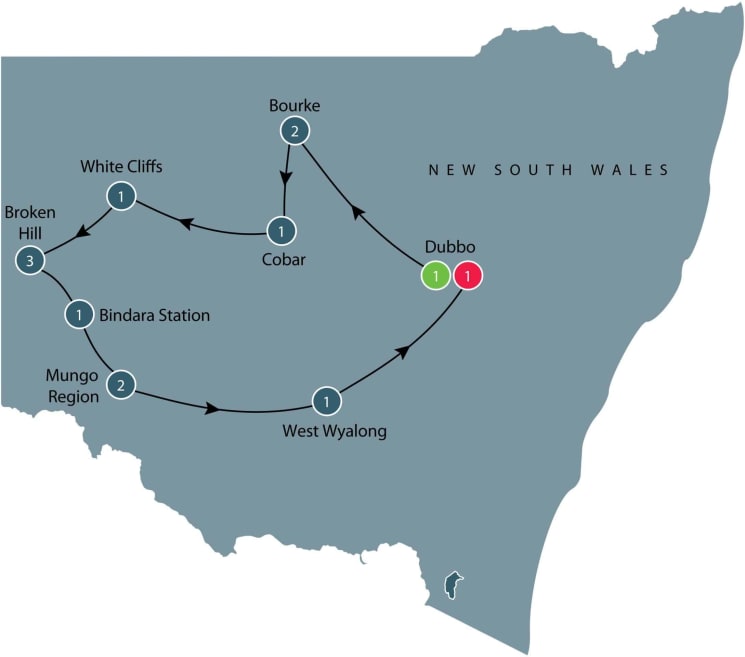
Departure Dates
| Departure Date | Price |
|---|---|
| 30 April 2024 Ends 13 May 2024 • 14 days $8,176 Twin $10,032 Single Available | Selected |
| 01 October 2024 Ends 14 October 2024 • 14 days $8,176 Twin $10,032 Single Available |
Small group tour of Western New South Wales
An escorted small group Australian outback tour for mature and senior travellers is a journey of learning around the Southern edges of the Murray Darling basin and up to the upper southern part of this complex river basin north of Mildura. It provides the traveller on this escorted small group tour of Western New South Wales the learning opportunity to gain an insight into Aboriginal habitation land management over some 40,000 years and then more recently the veneer of European settlement in the last two centuries on the landscape. It is part of a portfolio of Australian Outback tours offered by Odyssey for like minded people who are curious about Outback Australia. The itinerary over the 14 days is from Dubbo to Dubbo.
This, like all Odyssey Traveller small group tours is limited to a maximum of 15 people.
This escorted small group tour has an interest in both Aboriginal and European settlement history. Over the period of this escorted small group tour the itinerary takes you to visit the UNSECO World Heritage Sites of Mungo Man and lady. Gain an understanding and appreciation of the complexity and features of the Murray Darling Basin through some spectacular scenery. The program skirts around the edges of the "Aussie Outback", but is not an outback adventure for the traveller. Whilst the Murray-Darling begins in Queensland, by the time the river system reaches New South Wales it represents one the most complex river systems in Australia against which modern agriculture has placed substantial stress. We see the historic and contemporary evidence of this in the lakes around Menindee. and the many landscape changes including the Mallee, observing and learning about the river woodland galleries, arid lands, saltbush plains, agriculture practices; as well as the mining and railway history of Southern Australia.
The Itinerary
This small group escorted tour with your tour guide meets in Dubbo where the trip begins and ends 14 days later.
Leaving Dubbo, our outback Australia tours itinerary follows the path of the iconic Cobb & Co. stagecoach to Dubbo via Ngynan. The outback town of Bourke has shaped the history of many of the places we will visit. Established in the mid-1950s as a developing town on the Darling River, by the 1890s Bourke became the focus of the world's wool industry. The Darling River had more than eighty boats transporting wool through the outback to ports like Adelaide. With the opening of railways in the early 20th century - which didn't have to deal with the unreliability of river flows - the end of river traffic in outback Australia was in decline.
Bourke today is a town with an outback spirit, on the edge of the wilderness, and with a great sense of Australian adventure in its historical, cultural, and geographic significance. The group spends time in Brewarrina, we stop off to see one of the world's oldest surviving man-made structures: the Brewarrina Fish Traps. The Ngemba people are the custodians of the fish traps, a complex aquaculture network estimated to be over 40, 000 years old. An elaborate network of rock weirs and pools form a series of complex dry-stone walls and holding ponds, stretching for around half a kilometre along the Barwon riverbed. For the Aboriginal people of western and northern New South Wales, the fish traps and surrounds are extremely significant for their spiritual, cultural, traditional and symbolic meanings. The creation of the fish traps, and the laws governing their use, helped shape the spiritual, political, social, ceremonial and trade relationships between Aboriginal groups from across the greater landscape. Brewarrina was one of the great Aboriginal meeting places of eastern Australia.
We'll stop to visit Mt. Oxley on our way back from Brewarrina to Bourke. Mt Oxley, that was once climbed by explorers Stuart and Hume in 1829 in search of the "inland sea".
The next morning we will spend some time exploring Bourke township before heading to our next destination, Cobar from where we visit the nearby Mount Grenfell historic site. We spend some time in Cobar to view the historic township and learn a little about its mining history and to Stanley Kidman. At Mount Grenfell where we have the opportunity to explore more amazing Aboriginal art works contained within this National Park.
In the late 1800s Cobar was Australia’s leading producer of copper and the economy boomed. At its peak the town had a population of 10,000 and, although this has declined greatly in modern times, mining still provides the town’s main industry. One of the local attractions is the extraordinary view over the open cut mine.
Mount Grenfell Historic Site protects the rock art of the Ngiyampaa people. For thousands of years before Europeans settled in this part of NSW, Ngiyampaa people regularly gathered around the semi-permanent waterhole and took shelter in the overhangs of what is now a national park. In the surrounding rocky ridge, you can see richly coloured paintings of human and animal figures, representations of the natural environment, and hand stencils which are of ceremonial significance to traditional owners. This extensive Aboriginal rock art is now protected within the park and can be reached following the short, relatively easy (3 kilometre return) Mount Grenfell art site walk.
After our stay in Cobar we will continue to White Cliffs via Wilcannia.
Broken Hill & Menindee
Our itinerary takes this small group Australian outback tour up to Broken Hill, an iconic destination in outback Australia. The tour arranges to visit Silverton nearby Broken Hill. Silverton's mining days are long over, but it has a place in the folklore of followers of the Mad Max films. The following day we have a full day tour, walking Broken Hill, including a visit to Pro Hart Gallery, before travelling out to Menindee and the lakes adjacent to the Darling River. We visit the places where Burke and Wills stayed before heading into the unchartered outback as well as visiting one of the major sheep stations now a national park.
Passing through the Mallee
In South-western New South Wales, this small group tour passes through swathes of mallee country. ‘Mallee woodlands’ have been listed by the Australian Department of Environment and Energy as one of the 32 ‘Major Vegetation Groups’ of Australia. Mallee country is defined by the predominance of the mallee eucalyptus, a stocky eucalyptus with several stems, which grows on semi-arid soil. Mallee country spreads in a belt across the south of Australia, centring around the Murray River in western Victoria and eastern South Australia, the Eyre Peninsula west of Adelaide, and the 'wheat belt' of Western Australia.
For European settlers, the mallee was a 'dreadful country', desolate and inhospitable, but Aboriginal Australians made a home in these areas for at least 40, 000 years. For the numerous Aboriginal groups who inhabited the Australian mallee, the Murray River was a source of life, providing fishing, meat, eggs, and fibrous water plants. The roots of kumpung were steamed in an earth oven, creating a carbohydrate starch similar to flour, which was in turn used to bake cakes. Kumpung was also used to create twine, which was used for fishing nets, the weaving of bags, belts, and headbands, and traded for stone axeheads and myall spears at great gatherings. Murray River peoples also used fire to create pasture mosaics.
Though each group held custodianship over particular lands, the Murray River peoples shared an overlapping culture, with closely-related languages and spiritual beliefs. People around the Murray River believed in an all-Father who was the creator of all things, though he bore different names to different peoples – Bunjil the eaglehawk to the Wotjobaluk and Kulin people, Tha-tha-pulli to the Wadi Wadi, and Tulong to the Dadi Dadi.
UNESCO World Heritage Site:
Mungo National Park has been a UNESCO World Heritage Site for some 40 years.
For travellers on this guided tour the fascinating part when looking at the landscape of Mungo and the Willandra Lakes is that it is a geological window where this small group tour can look into the deep past of old Australia. Buried here in thick layers of sand and clay are the tell-tale signs of how the climate, waters and landforms have changed over the last 100,000 years. And for at least 85,000 years humans have shared that journey. The ancient Willandra people thrived with the abundance of the lakes, then adapted to drier, hungrier times of the last ice age and survived to the present day. Their story can be discovered in the folds of the land, along with their fireplaces, burials, middens and tools. The people of Lake Mungo and the Willandra Lakes have a long past that is important to the whole world in archaeological studies and human evolution.
The history of these fossil lakes is deeply entwined with what has happened in the dune fields, rivers and mountains hundreds of kilometres away. A geological stable region sediment from the Queensland mountains has washed through the Australian outback and accumulated, piling up like the pages in a history book, waiting to be read in this national park. But here it is not just the recent geologically record that is important.
Lake Mungo is one of the most important archaeological sites in Australia. A unique set of circumstances have created a landscape where it is possible to get an insight into Aboriginal life some 40,000 years ago. At that time Lake Mungo was one of series of large, deep, interlocking lakes teeming with large fish. It was 20 km long, 10 km wide and 15 m deep. On the lake's eastern shore sand dunes provided sheltered campsites. Not surprisingly Aboriginal hunters and gatherers settled on the shores, established campsites and enjoyed a healthy diet of fish, crustaceans and animals which came to drink at the water's edge.
About 40,000 years ago, Mungo Lady lived around the shores of Lake Mungo. A time of plenty was coming to an end at Willandra Lakes, when the basins were full of water and teeming with life. The human population was at its peak, and Mungo Lady was the daughter of many mothers - the generations before her that had lived at Lake Mungo since the Dreamtime. She collected bush tucker such as fish, shellfish, yabbies, wattle seeds and emu eggs, nourished her culture and taught her daughters the women's lore.
When Mungo Lady died, we know her family mourned for her. Her body was cremated, the remaining bones were crushed, burned again and then buried.
About 42,000 -40,000 years ago out here in what is now the Australian outback, Mungo Man lived around the shores of Lake Mungo with his family. A time of abundance in the Willandra Lakes system was drawing to a close, but he could still hunt many species of game, including some of the soon-to-be-extinct megafauna. Mungo Man cared for his Country and kept safe the special men's knowledge. By his lore and ritual activity, he kept the land strong and his culture alive.
When he was young Mungo Man lost his two lower canine teeth, possibly knocked out in a ritual. He grew into a man nearly 1.7m in height. Over the years his molar teeth became worn and scratched, possibly from eating a gritty diet or stripping the long leaves of water reeds with his teeth to make twine. As Mungo Man grew older his bones ached with arthritis, especially his right elbow, which was so damaged that bits of bone were completely worn out or broken away. The condition of arthritis was so advanced that he would not have been able to fully extend his arm or turn his hand properly. Such wear and tear is typical of people who have used a woomera to throw spears over many years.
Ancient footprints
A key feature of the Meeting Place interpretation centre in the UNESCO World heritage site National park is the re-creation of part of the ancient human tracks that were re-discovered in 2003. The footprints record some frozen moments in the lives of Aboriginal people who travelled across a damp claypan around 20,000 years ago. This is the largest known collection in the world of such ancient human footprints.
Today these fragile relics are specially protected. The footprints are extremely precious to the people who are directly descended from those who made them so long ago, and they are important to all humanity. To let everyone experience something of the wonder of the tracks, a section has been reproduced as an accurate replica at the Meeting Place.
The ability to go so far back in human settlement over such a large area makes for a truly fascinating and touching visit in the Mungo National park as part of this unique Australia tour. This escorted small group tour spends 2 days with the tour leader and local guides exploring and learning about the park, its unique wildlife and sees an amazing sunset, we hope.. in Australia's outback.
Balranald
This escorted group tour now heads to Ouyen and Balranald travelling through the flat land of wheat fields and grazing sheep.
Balranald is located on the western edge of the vast Hay plain initially settled as a place once used to ford the Murrumbidgee River. Today it is a service centre for the surrounding irrigation district. The Heritage Park in Market Street draws the historic interest of the area with the old gaol, the school house and an historical museum.
The following day our itinerary has this escorted small group tour heading across via Hay for an overnight stop at Griffith. The following morning we’ll continue to West Wyalong, stopping to admire the silo art at Weethalle. West Wyalong has a gold mining history and the main road running through the town has been nicknamed the “Crooked Mile” as it was built around gold diggings and tree stumps. Russell Drysdale famously sketched the street in 1949 during a visit with a friend.
From West Wyalong we’ll continue to Forbes and then Parkes to visit "The Dish" and then proceed Dubbo where this small group tour concludes after breakfast the following day.
Articles about Australia published by Odyssey Traveller:
- The Kimberley: A Definitive Guide
- Uncovering the Ancient History of Aboriginal Australia
- Aboriginal Land Use in the Mallee
- Understanding Aboriginal Aquaculture
- Mallee and Mulga: Two Iconic and Typically Inland Australian Plant Communities (By Dr. Sandy Scott).
- The Australian Outback: A Definitive Guide
For all the articles Odyssey Traveller has published for mature aged and senior travellers, click through on this link.
External articles to assist you on your visit to Australia:
- Finding Mungo Man: the moment Australia’s story suddenly changed
- A 42,000-Year-Old Man Finally Goes Home
- Fish traps and stone houses: New archaeological insights into Gunditjmara use of the Budj Bim lava flow of southwest Victoria over the past 7000 years
- ‘A big jump’: People might have lived in Australia twice as long as we thought
- Mildura, Victoria
Refreshed December 2020.
August 2021
Gallery

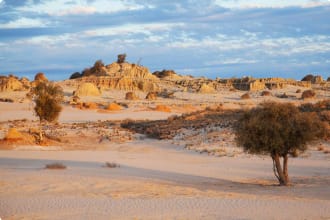
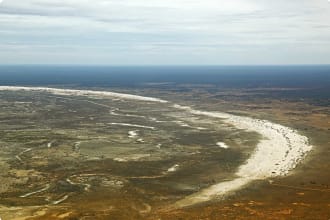
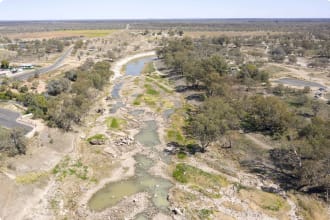
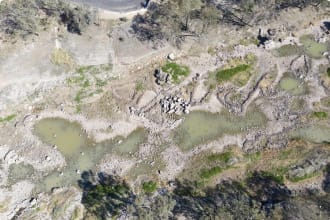

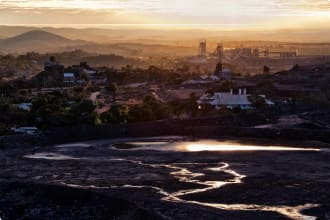

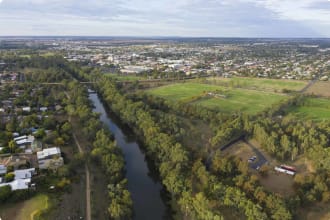
Itinerary
14 days
Day 1: Dubbo
Accommodation: Dubbo RSL motel or similar
We meet in the late afternoon as a group for an introduction to the tour program. Followed by a group evening meal.
(D)
Day 2: Bourke
Accommodation: Darling River motel or similar
Today, we depart Dubbo after breakfast we head west along the Mitchell Highway via Narromine and Nyngan. We’ll make our first major stop in Nyngan where we’ll be able to explore the town, find some lunch and visit the shearing shed museum.
In the afternoon we’ll continue west to Bourke where we’ll spend the next two nights.
Dinner tonight will be in a local restaurant.
(B)
Day 3: Bourke
Accommodation: Darling River motel or similar
This morning we take a drive towards the township of Brewarrina in order to visit the extraordinary Aboriginal fish traps. Here we will meet with our Aboriginal guide who will explain the working of the traps, still used by local children to catch fish in the traditional way.
The Brewarrina fish traps are estimated to be over 40,000 years old and one of the oldest man-made structures on earth. This elaborate network of rock weirs and pools stretches for around half a kilometre along the riverbed and was built by ancient tribes, to catch the fish as they swam upstream.
On our way back to Bourke we stop to visit Mt Oxley, that was once climbed by explorers Stuart and Hume in 1829 in search of the “inland sea”.
(B, L)
Day 4: Cobar
Accommodation: Cobar Oasis motel or similar
After breakfast we make a couple of stops around Bourke to visit some historic sites like the Old Bridge and the Old Cemetery.
We then continue our drive to Cobar. At its peak the town of Cobar had a population of 10,000 and, although this has declined greatly in modern times, mining still provides the town’s main industry. One of the local attractions is the extraordinary view over the open cut mine at Fort Bourke Hill Lookout.
From here, we make our way to visit to Mount Grenfell, and take a walk along the marked path and view some wonderful examples of Aboriginal rock art by the local Wongaibon people (this visit is weather dependent due to unsealed access road).
Mount Grenfell Historic Site protects the rock art of the Ngiyampaa people. For thousands of years before Europeans settled in this part of NSW, Ngiyampaa people regularly gathered around the semi-permanent waterhole and took shelter in the overhangs of what is now a national park. In the surrounding rocky ridge, you can see richly coloured paintings of human and animal figures, representations of the natural environment, and hand stencils which are of ceremonial significance to traditional owners. This extensive Aboriginal rock art is now protected within the park and can be reached following the short, relatively easy (3 kilometre return) Mount Grenfell art site walk.
Day 5: White Cliffs
Accommodation: The White Cliff hotel or similar
This morning we drive from Cobar to White Cliffs via Wilcannia, to view this historic town that was once the 3rd largest inland port (mid-19th century).
Opals were discovered at White Cliffs in the 1890s and miners flocked to the area hoping to make their fortunes. As in a number of opal towns, many of the inhabitants live underground.
Dinner tonight will be at our White Cliffs hotel.
(B, D)
Day 6: Broken Hill
Accommodation: The Lodge Outback motel or similar
We have time this morning to explore White Cliffs, with a visit to the underground mine and a visit to the dugout residence known as The White House. After lunch, we continue our journey to Broken Hill where we spend the next three nights.
On arrival at Broken Hill we’ll have our fist visit at Pro Hart Art Gallery, where we can learn more about the artists and view his work.
Dinner tonight will be in a local restaurant.
(B,D)
Day 7: Broken Hill
Accommodation: The Lodge Outback motel or similar
Today we spend in Broken Hill, starting with a guided tour of the historic centre. Broken Hill, Australia’s first Heritage Listed city, has always been associated with silver, lead and zinc mining. Many of the streets are named after metals, minerals and compounds and, during our tour, we will learn more about its links with the mining industry.
The group’s day tour of Broken hill, which was named by Charles Sturt, begins with a walking tour in the morning of Argent Street, Broken Hill’s Main Street with a local guide. Here Government influenced Architectural design from the Victorian period reigns, from the courthouse to the post office. The group gains an appreciation of the transformation from wild west mining to organised unionists managing the town.
We spend some time visiting the mining museum but what is also important gain an appreciation of the collective work of the “Brushmen of the Bush” so that as we travel into the landscape of the desert, the eye has an appreciation and understanding of this group of Artists.
Broken Hill has more art galleries than any other inland town or city in Australia as well as a strong Regional Art Gallery with works by Charles Blackman, Arthur Boyd, Clifton Pugh, and Lloyd Rees to view.
The Albert Kersten Mining and Minerals Museum, which we will visit at the end of our tour, will provide us with more detailed information about the history of mining in the region.
In the afternoon we will visit the the historic town of Silverton, established in 1883. It was once a thriving mining community, with a population of some 3000, but it now has just a few permanent residents. Some of the significant historic buildings, which are part of Silverton’s unique heritage, are well preserved and still in use today which we’ll visit: the School Museum and the Silverton Gaol. Australian poet, Dame Mary Gilmore, taught at Silverton between 1887-1889.
A third museum in the town is dedicated to Mad Max 2. At the end of our visits day we’ll have some time for dinner at the local hotel (own arrangements).
On our way back to Broken Hill we’ll stop at the Mundi Mundi Plains lookout for an incredible view of the surrounding area. The next stop is at the Living Desert and Sculptures Park, located just outside Broken Hill. Here we view the sculptures and enjoy the sunset before returning to our hotel.
The Living Desert is Broken Hill City Council’s contribution to the environment, for the protection of native flora and fauna and for the better management of our ecosystem and sustainability. It is located in the Barrier Ranges and is just 12km from the Broken Hill. It is a unique 2400ha reserve which was established in 1992. The sculptures were added to the park in 1983 and can be easily accessed via a walking trail that begins at the park’s picnic area.
(B)
Day 8: Broken Hill
Accommodation: The Lodge Outback motel or similar
The morning we’ll visit the Royal Flying Doctors Visitor Centre, located at their working base, next to the Broken Hill Airport. Following our tour, we return to the city and have some be free time until we meet-up again for our next visits. In the early afternoon we’ll visit the Synagogue Museum followed by the Afghan Mosque. The remainder of the day is at leisure.
(B)
Day 9: Menindee
Accommodation: Bindara Station or similar.
The township of Menindee is situated between the Menindee lakes and the Darling River. Established in 1852 by Thomas Pain, Menindee is the oldest European settlement in western NSW, and the first town to appear on the Darling. Back in the 1880s, the Darling saw cargo-laden paddle steamers churning their way to and from South Australia. In Menindee, we visit the places where Burke and Wills stayed before heading into the uncharted outback as well as visiting one of the major sheep stations now a national park that also has an association with the expedition.
Menindee is famous as the last stop of the ill-fated Burke and Wills expedition before it headed out into uncharted territory. It is also noted, except in times of extreme drought, as an inland wonderland for water birds and a vital source of water for neighbouring citrus orchards and vegetable farms.
From Menindee we will visit (weather and conditions permitting) the magnificent Kinchega National Park on our way to Bindara Station, where we hope to spend the night.
(B, D)
Day 10 : Mungo National park
Accommodation: Mungo Lodge or similar
This morning, after some time exploring Bindara Station, we drive to Mungo National Park.
Don’t expect there to be any water in Lake Mungo. That all dried up many thousands of years ago. Until 15,000, years ago, however, the region was often a vast lake, its waters rising and ebbing according to climatic change, making Mungo a preferred habitat for a dazzling diversity of wildlife. Giant kangaroos, wombats and other mega fauna roamed the land. A treasure trove of fossils is a legacy of this extraordinary heritage.
The abundance of the lake also made Mungo an ideal location for Aboriginal settlement. Tribes camped and fished along the shores, hunted for food and quarried stone from rock outcrops on the lake floor. Mungo is thus the site of one of earth’s longest continuous human habitations. The cremated remains of “Mungo Lady” and the skeleton of “Mungo Man”, found in the park, date back some 30,000 to 40,000 years.
Mungo National Park is the site of the famous “Great Walls Of China” and this evening we will take a guided sunset tour of the region before dinner at Mungo Lodge, our accommodation for the next two nights
(B, D)
Day 11: Mungo National Park
Accommodation: Mungo Lodge or similar
Today is a full day learning about the wildlife, and the all important archaeological discovery of Mungo man and lady. This is a major UNESCO world heritage site for archaeologists studying aboriginal culture and lifestyle. We have have knowledgeable local guides with us to explain what we are seeking and the intrepretation of the findings to date.
Mungo National Park has been a UNESCO World Heritage Site for some 40 years.
For travellers on this guided tour the fascinating part when looking at the landscape of Mungo and the Willandra Lakes is that it is a geological window where this small group tour can look into the deep past of old Australia. Buried here in thick layers of sand and clay are the tell-tale signs of how the climate, waters and landforms have changed over the last 100,000 years. And for at least 45,000 years humans have shared that journey. The ancient Willandra people thrived with the abundance of the lakes, then adapted to drier, hungrier times of the last ice age and survived to the present day. Their story can be discovered in the folds of the land, along with their fireplaces, burials, middens and tools. The people of Lake Mungo and the Willandra Lakes have a long past that is important to the whole world in archaeological studies and human evolution.
The history of these fossil lakes is deeply entwined with what has happened in the dunefields, rivers and mountainshundreds of kilometres away. A geological stable region sediment from the Queensland mountains has washed through the Australian outback and accumulated, piling up like the pages in a history book, waiting to be read in this national park. But here it is not just the recent geologically record that is important.
Lake Mungo is one of the most important archaelogical sites in Australia. A unique set of circumstances have created a landscape where it is possible to get an insight into Aboriginal life some 40,000 years ago. At that time Lake Mungo was one of series of large, deep, interlocking lakes teeming with large fish. It was 20 km long, 10 km wide and 15 m deep. On the lake’s eastern shore sand dunes provided sheltered campsites. Not surprisingly Aboriginal hunters and gatherers settled on the shores, established campsites and enjoyed a healthy diet of fish, crustaceans and animals which came to drink at the water’s edge.
About 16,000 years ago the lakes dried up leaving a 25 km-long sand dune, called a lunette, which stretched along the eastern edge of the lake and was, in places, up to 40 metres high. When shepherds, many of whom were Chinese, arrived in the area in the 1860s they called the lunette the Walls of China.
Lake Mungo’s importance are threefold.
- It has “one of the longest continual records of Aboriginal life in Australia ” having been occupied for over 50,000 years.
- The skeletons found in the sands of the lunette are the “oldest known fully modern humans outside Africa” and,
- the skeleton of Mungo Woman (or Mungo I as she is officially known), which has been radiocarbon dated to around 40,000 years ago, “has provided the oldest evidence of ritual cremation in the world.”
As a small group touring the lake and the National park, take time whilst at Lake Mungo to gaze across the dry lake bed to contemplate the idea that once, tens of thousands of years ago, here in the Australian outback was a important meeting place for the indigenous Aborigines. Aborigines painted themselves with ochre, ate fish and mussels from the lake, buried and cremated their dead, cooked meat in simple hearths and ovens, sewed skins to make cloaks and shaped bones and stones into tools and weapons. If you want to glimpse what life was like for Aborigines when our European ancestors were still living in caves then Lake Mungo is a genuinely unforgettable experience.
About 40,000 years ago, Mungo Lady lived around the shores of Lake Mungo. A time of plenty was coming to an end at Willandra Lakes, when the basins were full of water and teeming with life. The human population was at its peak, and Mungo Lady was the daughter of many mothers – the generations before her that had lived at Lake Mungo since the Dreamtime. She collected bush tucker such as fish, shellfish, yabbies, wattle seeds and emu eggs, nourished her culture and taught her daughters the women’s lore.
When Mungo Lady died, we know her family mourned for her. Her body was cremated, the remaining bones were crushed, burned again and then buried.
About 42,000 -40,000 years ago out here in what is now the Australian outback, Mungo Man lived around the shores of Lake Mungo with his family. A time of abundance in the Willandra Lakes system was drawing to a close, but he could still hunt many species of game, including some of the soon-to-be-extinct megafauna. Mungo Man cared for his Countryand kept safe the special men’s knowledge. By his lore and ritual activity, he kept the land strong and his culture alive.
When he was young Mungo Man lost his two lower canine teeth, possibly knocked out in a ritual. He grew into a man nearly 1.7m in height. Over the years his molar teeth became worn and scratched, possibly from eating a gritty diet or stripping the long leaves of water reeds with his teeth to make twine. As Mungo Man grew older his bones ached with arthritis, especially his right elbow, which was so damaged that bits of bone were completely worn out or broken away. The condition of arthritis was so advanced that he would not have been able to fully extend his arm or turn his hand properly. Such wear and tear is typical of people who have used a woomera to throw spears over many years.
Mungo Man reached a good age for the hard life of a hunter-gatherer, and died when he was about 50. His family mourned for him, and carefully buried him in the lunette, on his back with his hands crossed in his lap, and sprinkled with red ochre. Mungo Man is the oldest known example in the world of such a ritual.
When Mungo Lady and Mungo Man turned up some 40 years ago they rocked the scientific community. They have been dated to 42,000 years old – the oldest human remains in Australia and some of the oldest modern humans in the world outside Africa.
And when 20,000 year old footprints of the Willandra people were found in 2003, they also rocked archaeological records. They are the only Pleistocene footprints in Australia and the most numerous yet found anywhere in the world.
Ancient footprints
A key feature of the Meeting Place interpreatation centre in the UNESCO World heritage site National park is the re-creation of part of the ancient human tracks that were re-discovered in 2003. The footprints record some frozen moments in the lives of Aboriginal people who travelled across a damp claypan around 20,000 years ago. This is the largest known collection in the world of such ancient human footprints.
Today these fragile relics are specially protected. The footprints are extremely precious to the people who are directly descended from those who made them so long ago, and they are important to all humanity. To let everyone experience something of the wonder of the tracks, a section has been reproduced as an accurate replica at the Meeting Place.
These finds are remarkable enough in the Australian archeological record, but perhaps the most important thing about the Willandra Lakes is how such discoveries can be connected with the landscape and climate. Places like Mungo are rare, where changes in an environment can be matched with how people have lived there in a continuous record across vast ages.
The scientific evidence shows that Aboriginal people have lived at Mungo for at least 45,000 years. This is the dated age of the oldest stone artefacts that have been found so far, and represents a lineage that extends back over some 2000 generations. But many Aboriginal people say they have been here even longer, reaching back into the Dreamtime, perhaps forever. The long history of occupation at Mungo has combined with ideal conditions for the preservation of some types of relics to create an archaeological treasure house complete with Aboriginal rock art.
Today, the Paakantji, the Mutthi Mutthi, the Ngiyampaa and all Aboriginal people hold their Willandra ancestors and their story as precious gifts to be shared with all people.
The ability to go so far back in human settlement over such a large area makes for a truly fascinating and touching visit in the Mungo National park as part of this unique Australia tour. This escorted small group tour spends 2 days with the tourleader and local guides exploring and learning about the park, its unique wildlife and sees an amazing sunset, we hope.. in Australia‘s outback.
(B, L)
Day 12 : Griffith
Accommodation: Quest Griffith or similar
This morning we leave the park and drive through Balranald and Hay then on to Griffith, where we spend just one night. We’ll stop for morning tea in Balranald, a small town located on the Murrumbidgee River with a fascinating history.
From Balranald we head out across the Hay Plains, one of the flattest places on earth. There’s very little to see, in fact, in some places, you can turn in a complete circle and still see nothing…just flat country stretching out to the horizon with perhaps a little bit of low salt bush, a few sheep and the mirage of a water hole in the distance. It’s an extraordinary experience.
Hay, also on the Murrumbidgee, is an oasis in the semi-arid desert. Hay has a number of museums and we’ll pause to visit one of them (pending opening schedules). We’ll continue on to Griffith for our overnight.
(B)
Day 13: Dubbo
Accommodation: Dubbo RSL motel or similar.
We depart Griffith int he morning and stop along the way several times until we arrive back at Dubbo.
Our first stop will be to view the silo art at Wheethalle, followed by a lunch break at West Wyalong (own arrangements), and an afternoon stroll at Forbes.
We continue our journey at pause to visit the CSIRO Radio Telescope “The Dish” just outside Parkes and then proceed to Dubbo for our farewell dinner at a local restaurant..
This evening we have our farewell dinner in a local restaurant.
(B, D)
Day 14: Dubbo
The tour concludes after breakfast.
(B)
Includes / Excludes
What’s included in our Tour
- 13 nights accommodation.
- 13 breakfasts, 2 picnic lunches, 6 dinners.
- Transport by modern and comfortable 4wd or other vehicle suitable for the highway conditions.
- Entrances and sightseeing as specified.
- Services of Tour Leader for the duration of tour.
- Detailed Preparatory Information
What’s not included in our Tour
- Return airfares to Dubbo.
- Comprehensive travel insurance.
- Items of a personal nature, such as telephone calls and laundry
Participants must be able to carry their own luggage, climb and descend stairs, be in good health, mobile and able to participate in 3-5 hours of physical activity per day, the equivalent of walking / hiking up to 8 kilometers per day on uneven ground.
Book now
Make it a private tour
Easing your journey
Crossing international borders with restrictions
The list of requirements to travel internationally has changed and will continue to change for several years. Odyssey is here to assist you in managing your way through these requirements:
For more information see our Crossing international borders with restrictions page.
Book With Confidence
If less than 30 days before your tour starts you are unable to travel as a result of Government travel restrictions, Odyssey Traveller will assist you with a date change, provide you with a credit or process a refund for your booking less any non-recoverable costs.
See Terms and conditions for details.
Peace of Mind Travel
The safety of our travellers, tour leader, local guide and support staff has always been our top priority and with the new guidelines for public health and safety for keeping safe for destinations around the world, we’ve developed our plan to give you peace of mind when travelling with us.
See Peace of Mind Travel for details.
Reviews
Great to see places through the eyes of enthusiastic locals, small museums were particularly good. Janelle C. Oct'20
It was a real eye opener about the outback and people in country towns. Jill M. Oct '20
The tour of western NSW provides a unique opportunity to explore our own back yard. Learn its history, geography, and agriculture. See the work of indigenous people and colonial settlement. Experience life in this amazing area and meet the locals. Ann G. Oct '20
Reading List Download PDF
Cry Me A River: The Tragedy of the Murray-Darling Basin
Margaret Simons
The Murray-Darling Basin is the food bowl of Australia, and it's in trouble. What does this mean for the future - for water and crops, and for the people and towns that depend on it?
In Cry Me a River, acclaimed journalist Margaret Simons takes a trip through the Basin, all the way from Queensland to South Australia. She shows that its plight is environmental but also economic, and enmeshed in ideology and identity.
Her essay is both a portrait of the Murray-Darling Basin and an explanation of its woes. It looks at rural Australia and the failure of politics over decades to meet the needs of communities forced to bear the heaviest burden of change. Whether it is fish kills or state rivalries, drought or climate change, in the Basin our ability to plan for the future is being put to the test.
"The story of the Murray-Darling Basin ... is a story of our nation, the things that join and divide us. It asks whether our current systems - our society and its communities - can possibly meet the needs of the nation and the certainty of change. Is the Plan an honest compact, and is it fair? Can it work? Are our politics up to the task?"
Burke and Wills: The triumph and tragedy of Australia's most famous explorers
Peter FitzSimons
The iconic Australian exploration story - brought to life by Peter FitzSimons, Australia's storyteller.
'They have left here today!' he calls to the others. When King puts his hand down above the ashes of the fire, it is to find it still hot. There is even a tiny flame flickering from the end of one log. They must have left just hours ago.
MELBOURNE, 20 AUGUST 1860. In an ambitious quest to be the first Europeans to cross the harsh Australian continent, the Victorian Exploring Expedition sets off, farewelled by 15,000 cheering well-wishers. Led by Robert O'Hara Burke, a brave man totally lacking in the bush skills necessary for his task; surveyor and meteorologist William Wills; and 17 others, the expedition took 20 tons of equipment carried on six wagons, 23 horses and 26 camels.
Almost immediately plagued by disputes and sackings, the expeditioners battled the extremes of the Australian landscape and weather: its deserts, the boggy mangrove swamps of the Gulf, the searing heat and flooding rains. Food ran short and, unable to live off the land, the men nevertheless mostly spurned the offers of help from the local Indigenous people.
In desperation, leaving the rest of the party at the expedition's depot on Coopers Creek, Burke, Wills, Charley Gray and John King made a dash for the Gulf in December 1860. Bad luck and bad management would see them miss by just hours a rendezvous back at Coopers Creek, leaving them stranded in the wilderness with practically no supplies. Only King survived to tell the tale.
Yet, despite their tragic fates, the names of Burke and Wills have become synonymous with perseverance and bravery in the face of overwhelming odds. They live on in our nation's history - and their story remains immediate and compelling.
World Heritage Sites of Australia
Peter Valentine
Peter Valentine presents Australia’s 19 World Heritage sites in a magnificent tribute to natural and cultural history. The outstanding qualities of each site are described and illustrated in exquisite detail, along with an account of how the site came to be on the World Heritage List. In many cases, the path towards listing was not straightforward, with the Australian Government having to exercise its constitutional powers against other parties with vested interests in using sites for other purposes, including forestry and mining.
Rainforests that show the connections of the ancient super continent Gondwana. Rock art that points to a history of human settlement reaching over 60,000 years into the past.Sandstone remnants of eighty years of convict labour and imprisonment. A marvel of twentieth-century architecture. This is Australia’s world heritage.
In a thoughtful foreword, former minister for the environment, heritage and the arts and Midnight Oil lead singer Peter Garrett describes his own experience of these wonders and concern for their continued existence.


